Bias Response Systems
Investigations
Number of states that have them: 22 plus District of Columbia
Number of total school districts: 115
Number of total schools: 4,565
Number of total students: 2,492,241
(Scroll to bottom to see our list of districts that employ these bias response systems. This is not an exhaustive list and we will add to it as we become aware of more school that employ a bias response/reporting system.)
What is a bias response system?
A bias response, or reporting system, is a means in which students and staff, and sometimes the community, can report incidents of bias or biased actions perpetrated against an individual or group. While definitions can vary among institutions, according to Edwin O. Smith High School in Connecticut, a “bias-related incident” is an “incident that negatively targets, intimidates, or threatens an individual or group due to race, ethnicity, ancestry, national origin, religion, gender, sexual orientation, gender identity or expression, age, physical, mental, and intellectual disabilities, as well as past/present history of mental disorders.”
As part of the bias response system, many schools have in place specific individuals or teams that become involved in the process of both preventative and responsive actions. These actions can include counseling, remediation, restorative justice, or more punitive consequences.
Many districts, such as Acalanes Union High School District, offer students the option of making anonymous reports. Other districts only give reporters the option of using identifiable information.
According to “Responding to Hate and Bias at School,” a publication of Learning for Justice (a project of the Southern Poverty Law Center), “everyday acts of intolerance manifest themselves in many ways: name-calling, slurs, sexual harassment, casual putdowns regarding race, ethnicity, gender, size, abilities, perceived sexual orientation or gender identification.” The document states that the “issue is less about intent…and more about impact.” It continues: “If, for example, they allow a bigoted comment to go unchecked, they are offering tacit approval of similar comments.”
The document also lays out a checklist of examples of bias or potential bias events which include “casual pejoratives,” “school ‘pride’,” “assemblies and holidays,” and “student recognition.” The document states that “student recognition” can become a bias event because “long-standing traditions may contribute to a sense of entitlement among some students, and feelings of frustration or inadequacy in others.” Additionally, it asks “who is spotlighted and who is ignored? Is there a perception—fair or not—that athletes, advanced placement (AP) students and student leaders enjoy privileges or are disciplined less severely for misconduct?”
Why is this important?
Bias response systems, while intended to create a safe and “inclusive” environment, offer young children access to an anonymous snitch system. One which is vulnerable to abuse and misuse by not only children, but potentially by community members. While the intent is often meant with good intentions, these systems have also been used to stifle free speech.
According to a recent article in The Chronicle of Higher Education, the author states that while a bias response system is “designed to reduce anxiety among people who experience what they feel are bias incidents,” it is “in effect a mental-health intervention, acquiring the liabilities associated with any such intervention.” They conclude that “it is hard to find any evidence that they work.”
A Few Examples:
Acalanes, California
Acalanes Union High School District in California has a “Bias Incident Reporting System” page that states its system is “for students to report incidents of harm – acts of racism, bias, sexism, microaggressions, etc.” District students are allowed to make reports anonymously. The reporting system is “part of AUHSD’s effort to promote safe environments where all students can learn.” Describing what the district bias incident reporting system is “not,” it states that it is “not the thought or speech police.” It continues: “We do not tell people how to think or talk.”
A district document titled “Equity Definitions” defines bias as “an inclination or preference either for or against an individual or group that interferes with impartial judgment.” The document also defines microaggressions as “The everyday verbal, nonverbal, and environmental slights, snubs or insults whether intentional or unintentional which communicate hostile, derogatory, or negative messages to target persons based on their membership in historically marginalized group membership.” Additionally, it includes “microassault,” “microinsult,” and “microinvalidation.”
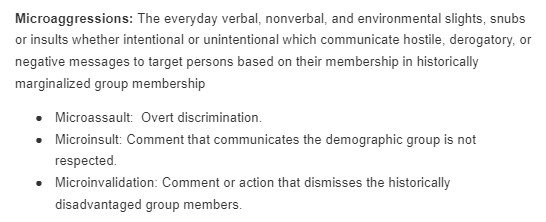
According to the district reporting procedures, examples of “disciplinary incidence” include “using the N-word,” “hate speech” and “bullying.” Examples provided for restoration include “a student saying something insensitive” or “commits a micro-aggression.”
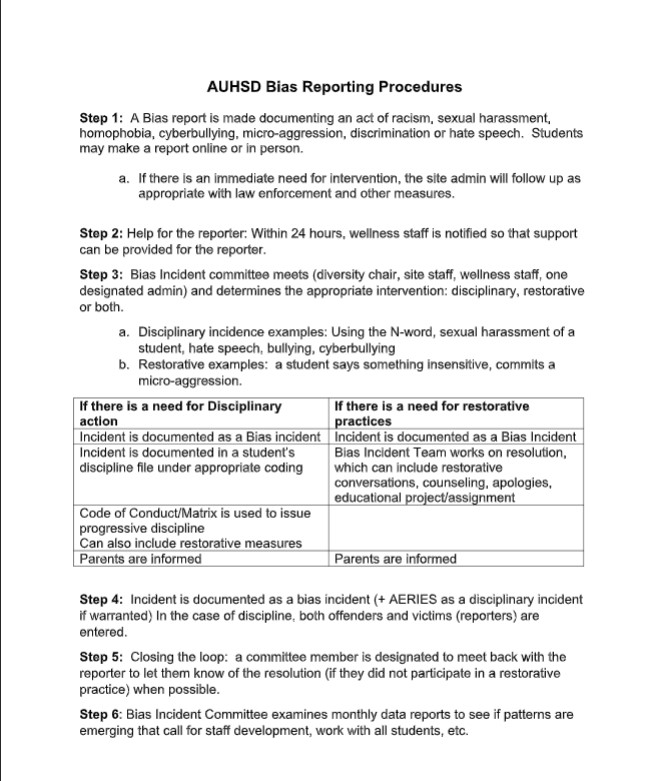
Monroe County, Indiana
The Monroe County Community School Corporation (IN) “Anti-racism” board policy states that its purpose is to “confront, mitigate and eliminate racism, racist behaviors and microaggressions in all forms.” The policy proclaims that the district will “commit to disrupt and dismantle any and all practices and behaviors that do not center equity and that result in disparate educational outcomes between racial and other marginalized groups.” Included in the district policy is the establishment of an “incident reporting system to make it clear that any act of racial discrimination (which may include race-based bullying and harassment, and other behaviors or threats of harm) by administration, staff, or students will not be tolerated in MCCSC schools.”
Additionally, district policy objectives provide “opportunities that include diverse student perspectives, voice, and lived experiences in the development of corporation and school wide programs, practices and procedures.” The district offers students the opportunity to apply to be “Student Equity Ambassadors,” who participate in giving input and creating the district’s anti-racism policy.
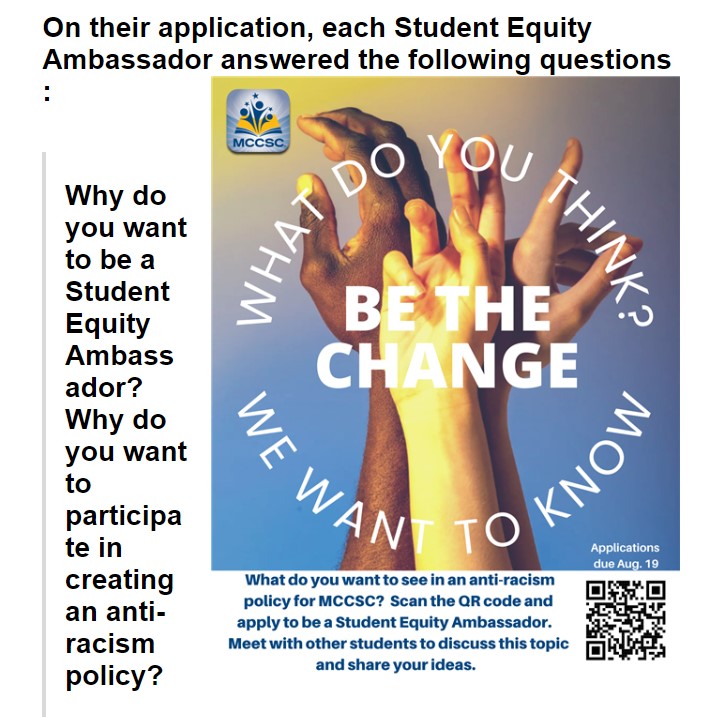
Student responses to why they want to become a Student Equity Ambassador include wanting to “cause change in the school” because of enduring “microaggressions on the daily, mainly be primarily unaware teachers.” Another student “experienced first-hand moments of bias from teachers skipping my name to not pronounce it to being called a slur by a classmate.” Additionally, a student states that “as a female, I can bring the point of view of being a societal minority, however, I do want to be honest that as a middle-class Caucasian I am in a place of immense privilege.”
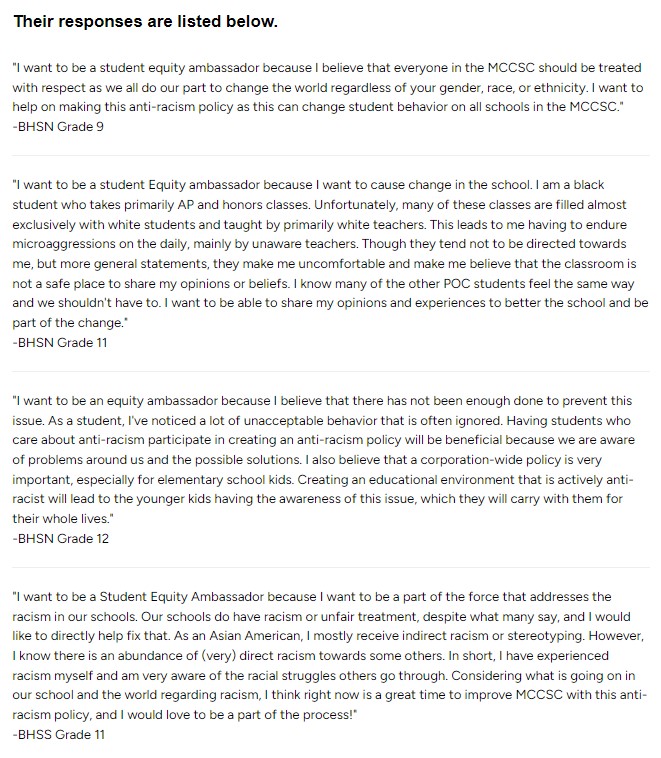
The Indiana school district provides students, staff, and the community with an online anonymous tip line to report “bullying, harassment, abuse, or safety concerns.”
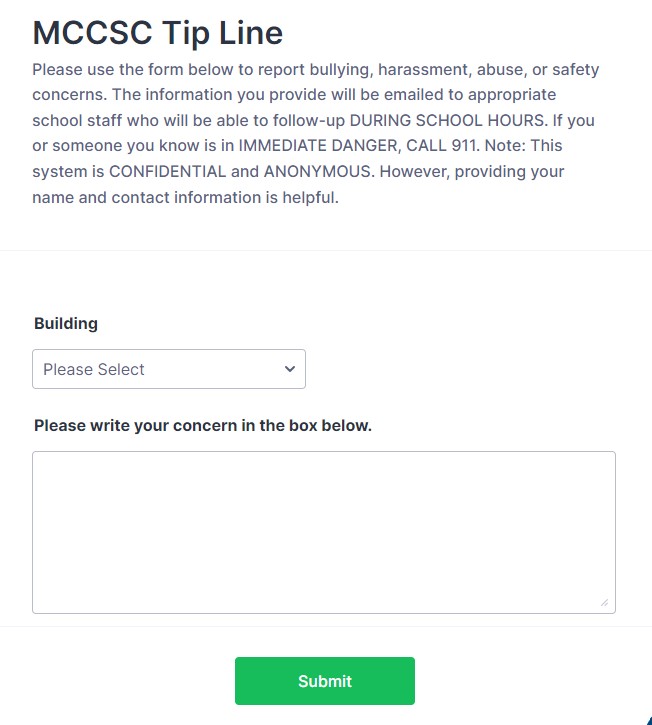
Jefferson County, Kentucky
In Kentucky, Jefferson County Public Schools contracts with Calls Plus to operate the district “Compliance Hotline.” Students have the ability to report incidents anonymously such as bullying, discrimination, and “racial intolerance.”
There is no definition provided for “racial intolerance;” however, it was revealed in the Cracked Foundations report that the district’s Affirming Racial Equity Tool defines “diverse” as “pertaining to any and all cultures that are NOT heterosexual, male-centered, white, Western, and/or Christian.”
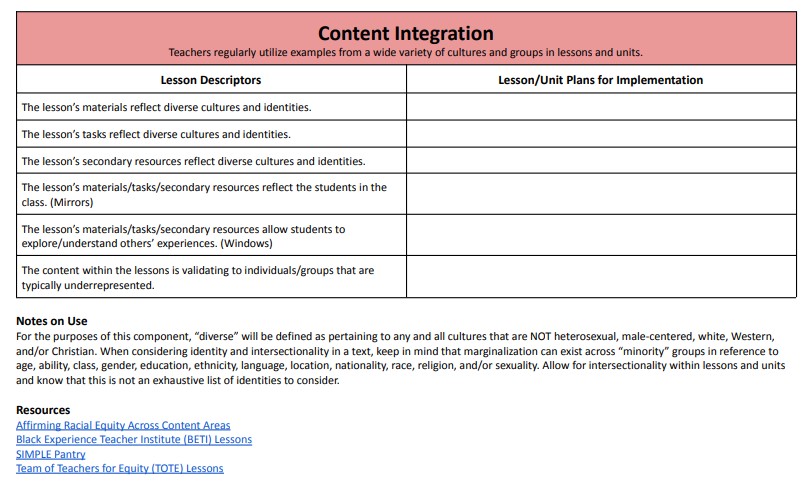
Webster Groves, Missouri
In 2021, Webster Groves School District (MO) passed its equity policy which states that the district “rejects all forms of racism and bias as destructive to the district’s mission, vision, values and goals.” According to its “Moving Toward Equity” document, district faculty, staff, and community “participated in a four-day social justice workshop focused on developing and/or deepening their understanding of privilege and oppression.” Teachers also attended a “Witnessing Whiteness Program” and “anti-racism/anti-bias training” program.
The district’s “Bias Incident Reporting” system is in place to create awareness of “incidents that may hinder” the “growth” of a “culture of dignity.” The reporting system is to be used to “document and address” incidents and “provide resources and support to students who experienced the bias.” The page states:
We encourage you to report any incidents that negatively impact our campus culture, especially those that are biased-related. The report should reference bias incidents – example racism, bias, sexism, microaggressions, etc. You may report on an incident that was done to you or to someone else. While bias incidents sometimes target specific individuals, they can also violate and offend an entire group or community. Thus, you may also report bias incidents such as defaced fliers, graffiti that includes offensive language, etc.
The “Student & Staff Bias Reporting System” form allows the individual to make an anonymous response of incidents that “negatively impact” district culture.
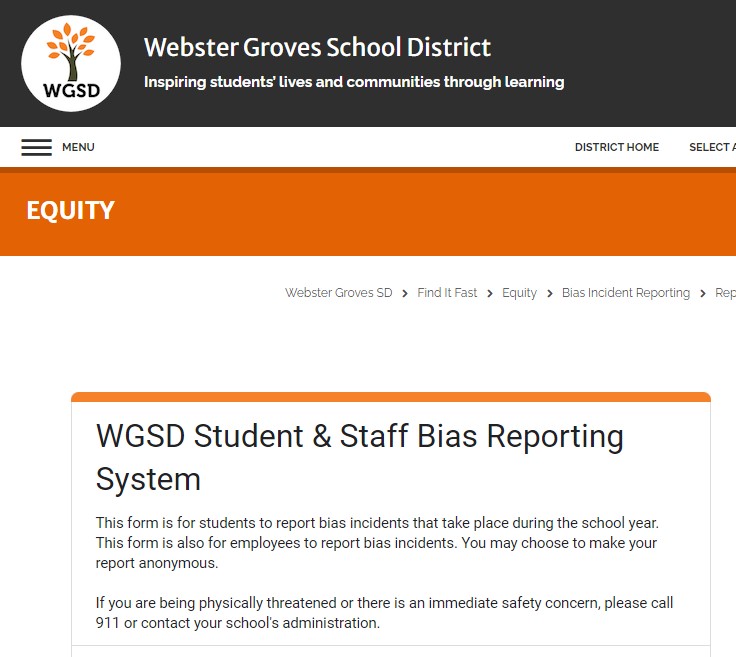
Mason City, Ohio
Mason City Schools’ (OH) bias reporting system calls upon students to report “acts of racism, sexism, ableism, classism, homophobia, religious intolerance, and other forms of harassment” through an anonymous “SafeSchools Tipline.” The district explains that “even when an act of bias is unintentional, the impact remains the same.”
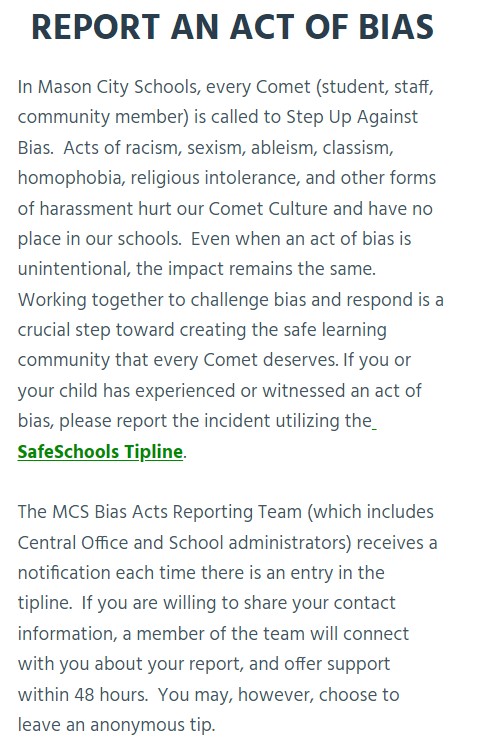
New Mexico
In 2021, New Mexico passed House Bill 43 titled the “Black Education Act.” The bill required “racial sensitivity and anti-racism training or professional development for school personnel.” Also included in the bill is the requirement to establish a statewide “hotline for reporting racially charged incidents and racialized aggression.” Schools are also legally required to link to the hotline on its website.
The “Anti-Racism/Anti Oppression (ARAO) Hotline” is a “resource created by the Black Education Act (House Bill 43) that is available for students, families, staff, community members, and other stakeholders to report school-based incidents of racism.”
The state website does not address or clarify specifics on what constitutes reportable incidents.
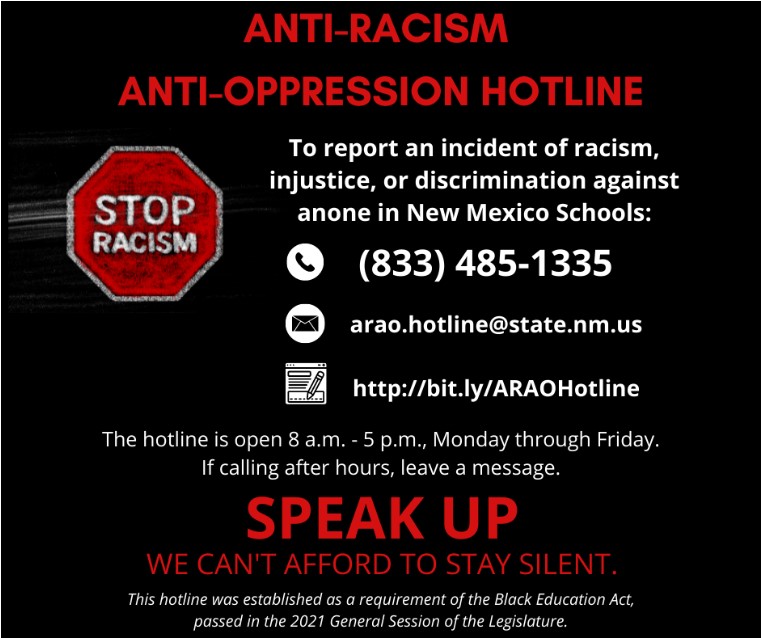
LIST OF DISTRICTS
California
Acalanes Union High School District
Alameda Unified School District
San Francisco Unified School District
Santa Clara Unified School District
Colorado
Connecticut
Georgia
Illinois
Illinois Math and Science Academy
Indiana
Monroe County Community School Corporation
Kentucky
Jefferson County Public Schools
Maryland
Montgomery County Public Schools
Massachusetts
Acton-Boxborough Regional School District
Bridgewater-Raynham Regional School District
Central Berkshire Regional School District
Concord- Carlisle Regional School District
Mount Greylock Regional School
Michigan
Plymouth-Canton Community Schools
Missouri
Webster Groves School District
New Jersey
North Hunterdon-Voorhees Regional School District
New Mexico
Aztec Municipal School District
Cobre Consolidated School District
Cuba Independent School District
Estancia Municipal School District
Gadsden Independent School District
Gallup-McKinley County Schools
Mora Independent School District
Pojoaque Valley School District
New York
Barker Central School District
Canandaigua City School District
Horseheads Central School District
Jamesville-Dewitt Central School District
New Paltz Central School District
Newburgh Enlarged City School District
Niskayuna Central School District
North Carolina
Chapel Hill-Carrboro City Schools
Ohio
Oregon
Lincoln County School District
Phoenix- Talent School District
Vermont
Essex Westford School District
Washington
Washington D.C.
Wisconsin
Stay Informed
